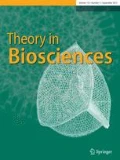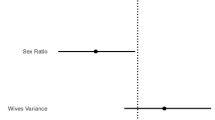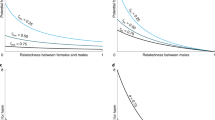Abstract
The aim of this study was an analytical justification of the emergence and presence of the phenomenon of war among hominins, taking into account males’ genetic benefits gained through war in the natural environment. Based on chimpanzee behavior, the analytical model of the primary warrior balance was explored, comparing the risk of a war expedition with the genetic profits from war rape—“life and death balance”. On the profits side, genetic gains possible to obtain in terms of permanent attractiveness of females (warrior status and abductions of females) were also included. Kin cooperation, parochial altruism, and “partisan strategy” have been defined as psychological mechanisms that enable effective group violence. Male genetic benefit from a war rape could exceed the risk of a warrior’s death in the chimpanzee–human LCA species; transition from the herd to the patriarchal tribal social system could increase warrior’s genetic gains from war. At the root of war lie sexual limitations of cooperating males, induced by female sexual preferences and lack of the permanent female sexual drive. War rape allows reproductive success for dominated and thus sexually restricted males. Tendencies for group aggression to gain access to out-group females (the war gene) are common among sexually restricted men. Resource-rich areas favor increase in human population density, this affects group territoriality and promotes intergroup conflicts, and thus patriarchy. Roots of conventional patriarchal marriage are strongly combined with war—“the right to land entails the right to a female”.




Similar content being viewed by others
References
Adams DB (1983) Why there are so few women warriors. Behav Sci Res 18(3):196–212
Alexander RD, Noonan KM (1979) Concealment of ovulation, parental care, and human social evolution. In: Chagnon NA, Irons WG (eds) Evolutionary biology and human social behavior: an anthropological perspective. Duxbury Press, North Scituate, Mass., pp 436–453
Allen B (1996) Rape warfare: The hidden genocide in Bosnia-Herzegovina and Croatia. University of Minnesota Press, Minneapolis
Alleyne E, Gannon TA, Ciardha CÓ, Wood JL (2014) Community males show multiple-perpetrator rape proclivity: development and preliminary validation of an interest scale. Sexual Abuse 26(1):82–104
Andersson M (1994) Sexual selection. Princeton University Press, Princeton, NJ
Andersson M, Iwasa Y (1996) Sexual selection. Trends Ecol Evol 11(2):53–58
Amir M (1971) Patterns in forcible rape. University of Chicago Press, Chicago
Apostolou M (2013) The evolution of rape: the fitness benefits and costs of a forced-sex mating strategy in an evolutionary context. Aggress Violent Beh 18(5):484–490
Aureli F, Schaffner CM, Boesch C, Bearder SK, Call J, Chapman CA, Holekamp K (2008) Fission-fusion dynamics: new research frameworks. Curr Anthropol 49(4):627–654
Axtell J (1981) The indian peoples of Eastern America: a documentary history of the sexes. Oxford University Press, Oxford
Basson R (2001) Human sex-response cycles. J Sexual Marital Therapy 27:33–43
Betzig LL (1986) Despotism and differential reproduction: a Darwinian view of history. Aldine Publishing Co, New York
Bowles S (2006) Group competition, reproductive leveling, and the evolution of human altruism. Science 314(5805):1569–1572
Bowles S (2009) Did warfare among ancestral hunter-gatherers affect the evolution of human social behaviors? Science 324(5932):1293–1298
Böhm R, Rusch H, Baron J (2020) The psychology of intergroup conflict: a review of theories and measures. J Econ Behav Organ 178:947–962
Brownmiller S (1975) Against our will: men, women and rape. Simon & Schuster, New York
Burnstein E, Crandall C, Kitayama S (1994) Some neo-Darwinian decision rules for altruism: weighing cues for inclusive fitness as a function of the biological importance of the decision. J Pers Soc Psychol 67:773–789
Chagnon NA (1988) Life histories, blood revenge, and warfare in a tribal population. Science 239:985–992
Chagnon NA (1992) Yanomamö: the last days of Eden. Harvest Books, San Diego
Choi JK, Bowles S (2007) The coevolution of parochial altruism and war. Science 318(5850):636–640
Darwin C (1871) The descent of man and selection in relation to sex. John Murray, London
Da Silva T, Harkins L, Woodhams J (2013) Multiple perpetrator rape: an international phenomenon. In: Horvath MAH, Woodhams J (eds) Handbook on the Study of Multiple Perpetrator Rape. Routledge, Abingdon, pp 30–56
De Waal FB (2006) Our inner ape: a leading primatologist explains why we are who we are. Penguin, UK
De Waal FB (2007) Chimpanzee politics: power and sex among apes. JHU Press.
DeVore I, Tooby J (1987) The reconstruction of hominid behavioral evolution through strategic modeling. In: Kinzey WG (ed) The evolution of human behavior: primate models. State University of New York Press, New York, pp 183–237
Divale WT (1972) Systemic population control in the middle and upper palaeolithic: inferences based on contemporary hunter-gatherers. World Archaeol 4(2):222–243
Duda P, Zrzavý J (2013) Evolution of life history and behavior in Hominidae: towards phylogenetic reconstruction of the chimpanzee–human last common ancestor. J Hum Evol 65(4):424–446
Eisler RT (1987) The chalice and the blade: our history, our future. Harper & Row, San Francisco
Ember M (1982) Statistical evidence for an ecological explanation of warfare. Am Anthropol 84:645–649
Ember CR, Ember M (1995) Warfare, aggression, and resource problems: SCCS codes. World Cultures 9:17–57
Engels F (2008) The origin of the family, private property and the state. Australia: El Faro Printing.
Escasa M, Gray PB, Patton JQ (2010) Male traits associated with attractiveness in Conambo. Ecuador Evolution and Human Behavior 31(3):193–200
Farr K (2009) Extreme war rape in today’s civil-war-torn states: A contextual and comparative analysis. Gend Issues 26(1):1–41
Farwell N (2004) War rape: New conceptualizations and responses. Affilia 19(4):389–403
Feldblum JT, Wroblewski EE, Rudicell RS, Hahn BH, paiva, T., Cetinkaya-Rundel, M., pusey, A. E., and Gilby, I. C. (2014) Sexually coercive male chimpanzees sire more offspring. Curr Biol 24:2855–2860
Ferguson RB (1990) Explaining war. In Haas J, editor. The anthropology of war. Cambridge University Press, New York
Fisher RA (1930) The genetical theory of natural selection. Oxford University Press, Oxford, UK
Fried MH (1967) The evolution of political society: an essay in political anthropology. Random House, New York
Fry DP, Söderberg P (2013) Lethal aggression in mobile forager bands and implications for the origins of war. Science 341(6143):270–273
Furuichi T (1997) Agonistic interactions and matrifocal dominance rank of wild bonobos (Pan paniscus) at Wamba. Int J Primatol 18(6):855–875
Gaunitz C, Fages A, Hanghøj K, Albrechtsen A, Khan N, Schubert M, de Barros Damgaard P (2018) Ancient genomes revisit the ancestry of domestic and Przewalski’s horses. Science 360(6384):111–114
Geary DC (2010) Male, female: The evolution of human sex differences. American Psychological Association, Washington, DC
Ghiglieri MP (1999) The dark side of man: tracing the origins of male violence. Perseus Publishing, Cambridge
Glowacki L, Wrangham R (2015) Warfare and reproductive success in a tribal population. Proc Natl Acad Sci 112(2):348–353
Glowacki L, Wilson ML, Wrangham RW (2020) The evolutionary anthropology of war. J Econ Behav Organ 178:963–982
Goodall J (1986) The chimpanzees of Gombe: patterns of behavior. Harvard University Press, Cambridge, MA
Gottschall JA, Gottschall TA (2003) Are per-incident rape-pregnancy rates higher than perincident consensual pregnancy rates? Hum Nat 14:1–20
Gowin S (2005) Berlin 1945. Edipresse, Warsaw ((in Polish))
Hamilton WD (1964) The genetical evolution of social behaviour. J Theor Biol 7(1):17–52
Hare B, Wobber V, Wrangham R (2012) The self-domestication hypothesis: evolution of bonobo psychology is due to selection against aggression. Anim Behav 83(3):573–585
Herdt, G. H. (Ed.). (1997). Rituals of manhood: male initiation in Papua New Guinea. New Brunswick, U.S.A.: Transaction Publishers.
Hey J (2005) On the number of New World founders: a population genetic portrait of the peopling of the Americas. PLoS Biol 3(6):0965–0975
Hodgson DL, Hodgson DL (2001) Once intrepid warriors: gender, ethnicity, and the cultural politics of Maasai development. Indiana University Press, Bloomington
Holland NR, DeLisi M (2014) The warrior gene. In: Delisi M, Vaugn MG (eds) The Routledge International Handbook of Biosocial Criminology. Columbia University Press, New York, pp 179–189
Holmes WG, Sherman PW (1982) The ontogeny of kin recognition in two species of ground squirrels. Am Zool 22(3):491–517
Holmes MM, Resnick HS, Kilpatrick DG, Best CL (1996) Rape-related pregnancy: estimates and descriptive characteristics from a national sample of women. Am J Obstet Gynecol 175:320–324
Ingold T (2002) Modes of subsistence: Hunting and gathering to agriculture and pastoralism. Companion encyclopedia of anthropology. Routledge Press, New York, pp 231–259
Keeley LH (1996) War before civilization: the myth of the peaceful savage. Oxford University Press, New York
Kelly RC (2005) The evolution of lethal intergroup violence. Proc Natl Acad Sci 102(43):15294–15298
Kelly RL (2013) From the peaceful to the warlike: ethnographic and archaeological insights into hunter-gatherer warfare and homicide. War, peace, and human nature: the convergence of evolutionary and cultural views.Oxford University Press, Oxford
Kluckhohn C, Leighton DC (1974) The Navaho, vol 72. Harvard University Press, Cambridge
Lambert PM (2002) The archeology of war: a North America perspective. J Archeol Res 10:207–241
Langergraber KE, Mitani JC, Vigilant L (2007) The limited impact of kinship on cooperation in wild chimpanzees. Proc Natl Acad Sci 104(19):7786–7790
Lee RB (1974) Male-female residence arrangements and political power in human hunter-gatherers. Arch Sex Behav 3(2):167–173
Lees S (2002) Carnal knowledge: rape on trail. The Women’s Press Ltd, London
Lehmann L, Feldman MW (2008) War and the evolution of belligerence and bravery. Proc R Soc b Biol Sci 275(1653):2877–2885
Malinowski B (2005). Marriage, kinship. In: Mencwel A Anthropology of culture. University of Warsaw Publishing House, (in Polish).
Manson JH, Wrangham RW, Boone JL, Chapais B, Dunbar RIM, Ember CR, Paterson JD (1991) Intergroup aggression in chimpanzees and humans [and comments and replies]. Curr Anthropol 32(4):369–390
Marlowe F (2004) Marital residence among foragers. Curr Anthropol 45(2):277–284
Marlowe FW, Berbesque JC (2012) The human operational sex ratio: effects of marriage, concealed ovulation, and menopause on mate competition. J Hum Evol 63(6):834–842
Maschner HD, Reedy-Maschner KL (1998) Raid, retreat, defend (repeat): the archaeology and ethnohistory of warfare on the North Pacific Rim. J Anthropol Archaeol 17:19–51
Mateo JM (2004) Recognition systems and biological organization: the perception component of social recognition. Ann Zool Fenn 41:729–745
Mattison SM (2011) Evolutionary contributions to solving the “Matrilineal Puzzle.” Hum Nat 22(1–2):64–88
McKibbin WF, Shackelford TK, Goetz AT, Starratt VG (2008) Why do men rape? An evolutionary psychological perspective. Rev Gen Psychol 12(1):86–97
McKinley J Jr. (1996) Rwanda's war legacy: Children born of rape. New York Times, New York
Micheletti AJ, Ruxton GD, Gardner A (2018) Why war is a man’s game. Proc R Soc B 285(1884):20180975
Mitani JC, Watts DP, Amsler SJ (2010) Lethal intergroup aggression leads to territorial expansion in wild chimpanzees. Curr Biol 20(12):R507–R508
Mogielnicki C, Pearl K (2020) Hominid sexual nature. Theory Biosci 139(2):191–207
Nishida T (1983) Alpha status and agonistic alliance in wild chimpanzees (Pan troglodytes schweinfurthii). Primates 24(3):318–336
Nolan PD (2003) Toward an ecological-evolutionary theory of the incidence of warfare in preindustrial societies. Sociol Theory 21(1):18–30
Otterbein KF (1970) The evolution of war: a cross-cultural study. HRAF Press, New Haven
Pardoe C (2014) Conflict and territoriality in Aboriginal Australia: evidence from biology and ethnography. Violence Warfare Among Hunter-Gatherers, pp 112–132
Pitman GR (2011) The evolution of human warfare. Philos Soc Sci 41(3):352–379
Power M (1991) The Egalitarians—human and chimpanzee: an anthropological view of social organization. Cambridge University Press, Cambridge
Pritzker B (2000) A Native American encyclopedia: History, culture, and peoples. Oxford University Press, Oxford
Raaum RL, Sterner KN, Noviello CM, Stewart CB, Disotell TR (2005) Catarrhine primate divergence dates estimated from complete mitochondrial genomes: concordance with fossil and nuclear DNA evidence. J Hum Evol 48(3):237–257
Ridley M (1994) The red queen: sex and the evolution of human nature. Penguin, UK
Rusch H (2013) Asymmetries in altruistic behavior during violent intergroup conflict. Evol Psychol 11(5):973–993
Shields WM, Shields LM (1983) Forcible rape: an evolutionary perspective. Ethol Sociobiol 4:115–136
Smith DL (2007) The most dangerous animal: human nature and the origins of war. St Martin’s Press, New York
Smuts B (1985) Sex and friendship in baboons. Aldine, Chicago
Smuts B (1992) Male aggression against women: an evolutionary perspective. Hum Nat 3(1):1–44
Takai A (2011) Rape and forced pregnancy as genocide before the Bangladesh tribunal. Temple Int Comp Law J 25:395
Thornhill R (1999) The biology of human rape. Jurimetrics J 39:137–147
Thornhill R, Palmer CP (2000) A natural history of rape. The MIT Press, Cambridge
Tooby J, Cosmides L (1988) The evolution of war and its cognitive foundations. Inst Evol Stud Tech Rep 88(1):1–15
Touquet H, Gorris E (2016) Out of the shadows? The inclusion of men and boys in conceptualisations of wartime sexual violence. Reprod Health Matters 24(47):36–46
Turchin P, Korotayev AV (2006) Population dynamics and internal warfare: a reconsideration. Soc Evol History 5(2):121–158
van der Dennen JMG (1995) The origin of war: the evolution of a male-coalitional reproductive strategy, Vols. 1 & 2. Origin Press, Groningen
van Schaik CP, Dunbar RI (1990) The evolution of monogamy in large primates: a new hypothesis and some crucial tests. Behaviour 115(1–2):30–61
Vugt M (2009) Sex differences in intergroup competition, aggression, and warfare. Ann N Y Acad Sci 1167(1):124–134
Vugt MV, Cremer DD, Janssen DP (2007) Gender differences in cooperation and competition: the male-warrior hypothesis. Psychol Sci 18(1):19–23
Wade N (2006) Before the dawn: recovering the lost history of our ancestors. Penguin, UK
Shoemaker N (1991) The rise or fall of Iroquois women. J Women's History 2(3):39–57
Vlachova M, Biason L (eds) (2005) Women in an insecure world: Violence against women, facts, figures, and analysis. Geneva, Switzerland: Geneva Centre for the Democratic Control of Armed Forces.
Walker RS, Hill KR, Flinn MV, Ellsworth RM (2011) Evolutionary history of hunter-gatherer marriage practices. PLoS ONE 6(4):e19066
Wallström M (2014) Sexual violence as a weapon of war. (available on: http://www.unic.un.org.pl/aktualnosci/35,2595,,,/) (in Polish).
Watts DP (1996) Comparative socioecology of gorillas. In: McGrew WC, Marchant LF, Nishida T (eds) Great ape societies. Cambridge University Press, Cambridge, pp 16–28
Wettlaufer J (2000) The jus primae noctis as a male power display: a review of historic sources with evolutionary interpretation. Evol Hum Behav 21(2):111–123
Widlok T, Tadesse WG (eds) (2005) Property and equality (Vol. 2). Berghahn Books, Oxford
Wilson EO (1978) On human nature. Harvard University Press, Cambridge, MA
Wilson ML, Britton NF, Franks NR (2002) Chimpanzees and the mathematics of battle. Proc R Soc Lond Ser B Biol Sci 269(1496):1107–1112
Wood EJ (2006) Variation in sexual violence during war. Polit Soc 34(3):307–342
Wrangham RW, Peterson D (1996) Demonic males: apes and the origins of human violence. Houghton Mifflin, Boston, MA
Wrangham RW (1999) Evolution of coalitionary killing. Am J Phys Anthropol 110(S29):1–30
Wrangham RW (2001) Out of the pan, into the fire: How our ancestors’ evolution depended on what they eat. In: de Waal F (ed) Tree of origins: What primate behavior can tell us about human social evolution. Harvard University Press, Cambridge
Wrangham RW, Wilson ML, Muller MN (2006) Comparative rates of violence in chimpanzees and humans. Primates 47(1):14–26
Wrangham RW, Glowacki L (2012) Intergroup aggression in chimpanzees and war in nomadic hunter-gatherers. Hum Nat 23(1):5–29
Wroblewski EE, Murray CM, Keele BF, Schumacher-Stankey JC, Hahn BH, Pusey AE (2009) Male dominance rank and reproductive success in chimpanzees. Pan Troglodytes Schweinfurthii Animal Behaviour 77(4):873–885
Author information
Authors and Affiliations
Corresponding author
Additional information
Publisher's Note
Springer Nature remains neutral with regard to jurisdictional claims in published maps and institutional affiliations.
Rights and permissions
Springer Nature or its licensor (e.g. a society or other partner) holds exclusive rights to this article under a publishing agreement with the author(s) or other rightsholder(s); author self-archiving of the accepted manuscript version of this article is solely governed by the terms of such publishing agreement and applicable law.
About this article
Cite this article
Mogielnicki, C. Wartime forced sex as a male mating strategy. Theory Biosci. 142, 67–85 (2023). https://doi.org/10.1007/s12064-023-00386-0
Received:
Accepted:
Published:
Issue Date:
DOI: https://doi.org/10.1007/s12064-023-00386-0




